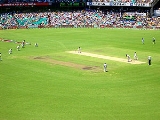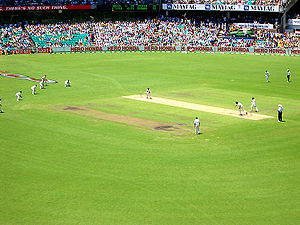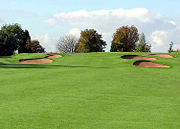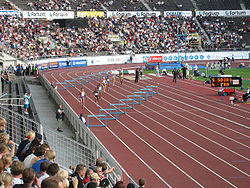
Turf management
Encyclopedia
Turf management or pitchcare describes the work needed to keep a sporting pitch ready for use. This article looks at the various types of sporting pitches and the type of challenges which they present.
The skills needed vary considerably dependent upon the sport
and whether or not artificial surfaces are used. Special sets of skills are also needed to care for either sand-based athletic fields
or native soil fields.
 Cricket pitch
Cricket pitch
es are mainly natural grass
with infrequent replacement of the playing surface. Cricket pitches are unusual in that they have to last for up to 5 days of play and the way that the pitch will change over time is an essential part of the sport. The English cricket board
has published a definitive paper on pitch properties and performance. The properties of an ideal cricket pitch have been identified as
Research has also identified the ideal soil
as having between 27% and 33% clay
. Less than this will hinder binding of the grass
. More than this will make for a heavy pitch which takes longer to dry out and is more difficult to handle.
There should be between 3% and 8% of organic matter
in the soil
.Above 8% there will be problems with water retention and soil strength.
Cricket pitches are often viewed as a long term investment. A poor year of maintenance can influence the performance of the pitch many years later.
Cricket pitches occasionally use under soil drainage .
, grass
and clay
. The clay courts can then be divided into natural clay, hard courts and fast/dry courts.
All tennis courts should ideally be a little west of true north to ensure minimum problems from sunlight.
The skills needed to maintain a grass court are considerable. Traditionally the court is split into the foundations and drainage, the soil or binding layer and the grass. All three must work together to provide the best playing surface. Maintenance of grass courts is typically split into the following areas
Artificial grass courts are a popular option at club level as they are weather resistant and their shock absorbing qualities help limit injuries. However they are not recommended for high skill levels and are expensive to maintain. The Lawn Tennis Association
cost a basic court at £27,000 and replacement turf every 9 years, a further £11,000.
An interesting problem with asphalt
courts arises in very hot environments. The asphalt absorbs heat very quickly, however the painted lines will reflect the heat and this differential in temperature can lead to surface cracking.
These courts are generally low maintenance but they will need to be recoated every 5 to 10 years. Most maintenance involves keeping the surface clean.
There is generally little movement in the surface which means added strain on ankles and knee joints.
The Lawn Tennis Association
costs a porous macadam court at £20,000 and it should last 10 to 12 years with low maintenance costs. An acrylic court would cost around £25,000 and is long lasting with low maintenance.
 The growth in the popularity of golf
The growth in the popularity of golf
, combined with the large sums of money invested in a golf course has led to the development of turf management which is a term used to refer to the skills of maintaining a golf course.
The green, as opposed to the rough, is the principal area of concern. Many golf courses are now built in environments which would be hostile to natural grass cover and essentially the grass grows in a hydroponic or sterile environment with very fast drainage. This means that it has to be fed and watered regularly.
The key characteristics of a good green are speed and consistency. Faster greens are preferred and for tournament play the greens should be as fast as possible. To measure speed a Stimpmeter
is used. The main factors influencing green speed are:
cover. The stresses on a pitch , combined with winter weather can often mean that the pitch has to be returfed on a regular basis. Essentially the existing turf is removed to a depth of typically 40 mm turf and 110 mm of soil. The replacement turf is ideally purpose grown to ensure consistency and freedom from weeds. A pitch can usually be returfed within 4 days and would, typically involve removing and relaying 400 cubic metres of turf and soil.
The FA
recommends 4 main characteristics of a good grass
pitch.
A football pitch should have undersoil drainage, up to 8 miles of pipe for a normal sized pitch. Increasingly these same pitches will have undersoil heating.
Artificial grass offers an alternative to natural grass for football stadia. There has been considerable development of this type of surface from the early days when it was very similar to tufted carpet. The performance of this surface has generally been questioned as not being truly natural. However there are definite advantages with artificial grass, particularly when a stadia has heavy or multi use requirements. Also when the environment is hostile to natural grass, for instance low sunlight or a paucity of water.

Modern athletics
tracks use “polymeric surfaces”. Because of their hardwearing and porous nature they allow the facility to look attractive and well-kept at all times, although actual maintenance is low.
The skills needed vary considerably dependent upon the sport
Sport
A Sport is all forms of physical activity which, through casual or organised participation, aim to use, maintain or improve physical fitness and provide entertainment to participants. Sport may be competitive, where a winner or winners can be identified by objective means, and may require a degree...
and whether or not artificial surfaces are used. Special sets of skills are also needed to care for either sand-based athletic fields
Sand-based athletic fields
Sand-based athletic fields are sporting grounds constructed on sand. They can have certain advantages over those built on native soils.-Choice of soil:...
or native soil fields.
Cricket pitches

Cricket pitch
In the game of cricket, the cricket pitch consists of the central strip of the cricket field between the wickets - 1 chain or 22 yards long and 10 feet wide. The surface is very flat and normally covered with extremely short grass though this grass is soon removed by wear at the ends of the...
es are mainly natural grass
Grass
Grasses, or more technically graminoids, are monocotyledonous, usually herbaceous plants with narrow leaves growing from the base. They include the "true grasses", of the Poaceae family, as well as the sedges and the rushes . The true grasses include cereals, bamboo and the grasses of lawns ...
with infrequent replacement of the playing surface. Cricket pitches are unusual in that they have to last for up to 5 days of play and the way that the pitch will change over time is an essential part of the sport. The English cricket board
England and Wales Cricket Board
The England and Wales Cricket Board is the governing body of cricket in England and Wales. It was created on 1 January 1997 combining the roles of the Test and County Cricket Board, the National Cricket Association and the Cricket Council...
has published a definitive paper on pitch properties and performance. The properties of an ideal cricket pitch have been identified as
- Bounce, technically measured as the vertical rebound height of a ball dropped from 3 metres.
- Pace, the degree to which a ball is slowed on hitting the pitch.
- Consistency. Consistency of bounce is reported to be the most valued characteristic of a good pitch.
- Turn. This refers to the ability of the ball to turn away from the line of trajectory. A thin grass covering has been calculated to have up to 30% less frictionFrictionFriction is the force resisting the relative motion of solid surfaces, fluid layers, and/or material elements sliding against each other. There are several types of friction:...
on a bouncing ball. However it is believed that the most significant contribution to turn comes from pitch damage as the game progresses.
Research has also identified the ideal soil
Soil
Soil is a natural body consisting of layers of mineral constituents of variable thicknesses, which differ from the parent materials in their morphological, physical, chemical, and mineralogical characteristics...
as having between 27% and 33% clay
Clay
Clay is a general term including many combinations of one or more clay minerals with traces of metal oxides and organic matter. Geologic clay deposits are mostly composed of phyllosilicate minerals containing variable amounts of water trapped in the mineral structure.- Formation :Clay minerals...
. Less than this will hinder binding of the grass
Grass
Grasses, or more technically graminoids, are monocotyledonous, usually herbaceous plants with narrow leaves growing from the base. They include the "true grasses", of the Poaceae family, as well as the sedges and the rushes . The true grasses include cereals, bamboo and the grasses of lawns ...
. More than this will make for a heavy pitch which takes longer to dry out and is more difficult to handle.
There should be between 3% and 8% of organic matter
Organic matter
Organic matter is matter that has come from a once-living organism; is capable of decay, or the product of decay; or is composed of organic compounds...
in the soil
Soil
Soil is a natural body consisting of layers of mineral constituents of variable thicknesses, which differ from the parent materials in their morphological, physical, chemical, and mineralogical characteristics...
.Above 8% there will be problems with water retention and soil strength.
Cricket pitches are often viewed as a long term investment. A poor year of maintenance can influence the performance of the pitch many years later.
Cricket pitches occasionally use under soil drainage .
Tennis Courts
There are two main types of tennis courtTennis court
A tennis court is where the game of tennis is played. It is a firm rectangular surface with a low net stretched across the center. The same surface can be used to play both doubles and singles.-Dimensions:...
, grass
Grass
Grasses, or more technically graminoids, are monocotyledonous, usually herbaceous plants with narrow leaves growing from the base. They include the "true grasses", of the Poaceae family, as well as the sedges and the rushes . The true grasses include cereals, bamboo and the grasses of lawns ...
and clay
Clay
Clay is a general term including many combinations of one or more clay minerals with traces of metal oxides and organic matter. Geologic clay deposits are mostly composed of phyllosilicate minerals containing variable amounts of water trapped in the mineral structure.- Formation :Clay minerals...
. The clay courts can then be divided into natural clay, hard courts and fast/dry courts.
All tennis courts should ideally be a little west of true north to ensure minimum problems from sunlight.
- Grass courts. Historically very popular they are now slowly being replaced by clay courts which offer the opportunity of year round usage and lower maintenance.
The skills needed to maintain a grass court are considerable. Traditionally the court is split into the foundations and drainage, the soil or binding layer and the grass. All three must work together to provide the best playing surface. Maintenance of grass courts is typically split into the following areas
- Mowing, 6 to 8 mm
- Fertilisers.
- Scarification. Mechanically raising the surface turf to prevent compaction.
- Rolling. Usually done is springtime to correct any problems from the winter weather.
- AerationLinear aerationLinear aeration is a relatively new aeration process; it allows water to penetrate the soil and to be retained in the proper amounts. Linear aeration also adds organic nutrition, soil softeners if necessary.-Gardens:...
. Winter work to remedy compaction over the summer. It will encourage deep rooting as well as assisting in drainage. - Seeding or worn areas after the season has ended.
- Top dressing at the end of the season to maintain turf quality.
Artificial grass courts are a popular option at club level as they are weather resistant and their shock absorbing qualities help limit injuries. However they are not recommended for high skill levels and are expensive to maintain. The Lawn Tennis Association
Lawn Tennis Association
The Lawn Tennis Association is the national governing body of tennis in Great Britain, the Channel Islands and the Isle of Man.As the governing body, the LTA is responsible for the coaching and development of junior players, offering courses and qualifications on coaching, as well as the...
cost a basic court at £27,000 and replacement turf every 9 years, a further £11,000.
- Clay courtClay courtA clay court is one of the four different types of tennis court. Clay courts are made of crushed shale, stone or brick. The red clay is slower than the green, or Har-Tru "American" clay. The French Open uses clay courts, making it unique among the Grand Slam tournaments.Clay courts are more common...
s. Clay courts require water to keep from cracking. This limits their use in both very dry regions. At the other extreme countries like the United kingdom with very wet seasons can make a Clay court unplayable for long periods and also give rise to expensive maintenance at the start of the season. Normal maintenance is basically regular watering and rolling. This prevents the surface turning into dust. Clay courts can have both sub surface and above surface irrigation. They provide a good training surface with a medium to slow pace and consistent bounce. The Lawn Tennis AssociationLawn Tennis AssociationThe Lawn Tennis Association is the national governing body of tennis in Great Britain, the Channel Islands and the Isle of Man.As the governing body, the LTA is responsible for the coaching and development of junior players, offering courses and qualifications on coaching, as well as the...
prices the courts at between £34,000 and £60,000 to construct.
- Hard courts. Typically made from asphaltAsphaltAsphalt or , also known as bitumen, is a sticky, black and highly viscous liquid or semi-solid that is present in most crude petroleums and in some natural deposits, it is a substance classed as a pitch...
or concreteConcreteConcrete is a composite construction material, composed of cement and other cementitious materials such as fly ash and slag cement, aggregate , water and chemical admixtures.The word concrete comes from the Latin word...
with an acrylic covering. They are also called synthetic granular courts. These courts typically provide a “fast” game which means the tennis ball will bounce with a low angle. The speed of the court can be changed by varying the amount of sand present in the covering. If a layer of cushioning material is added to a hard court then the performance increases and this is typical of an all weather court. However the cost of the cushioning can be substantial.
An interesting problem with asphalt
Asphalt
Asphalt or , also known as bitumen, is a sticky, black and highly viscous liquid or semi-solid that is present in most crude petroleums and in some natural deposits, it is a substance classed as a pitch...
courts arises in very hot environments. The asphalt absorbs heat very quickly, however the painted lines will reflect the heat and this differential in temperature can lead to surface cracking.
These courts are generally low maintenance but they will need to be recoated every 5 to 10 years. Most maintenance involves keeping the surface clean.
There is generally little movement in the surface which means added strain on ankles and knee joints.
The Lawn Tennis Association
Lawn Tennis Association
The Lawn Tennis Association is the national governing body of tennis in Great Britain, the Channel Islands and the Isle of Man.As the governing body, the LTA is responsible for the coaching and development of junior players, offering courses and qualifications on coaching, as well as the...
costs a porous macadam court at £20,000 and it should last 10 to 12 years with low maintenance costs. An acrylic court would cost around £25,000 and is long lasting with low maintenance.
- “Fast/dry” courts. A relatively new innovation from America. These are generally made from basalt taken from the Blue Ridge Mountains of Virginia which is then finely crushed and used as the top layer over either a purpose built sub layer or just placed on top of an existing clay or asphalt. This type of surface is promoted as allowing more “sliding” by the players and therefore it helps to limit tennis injuries to the lower parts of the body. These courts are typically slower than grass. They can dry very quickly and do not have the heat reflection problems of clay courts. Porosity is low and often these courts will have a slight slope to aid water run off. These courts are similar to the basic clay court described above.
Golf courses

Golf
Golf is a precision club and ball sport, in which competing players use many types of clubs to hit balls into a series of holes on a golf course using the fewest number of strokes....
, combined with the large sums of money invested in a golf course has led to the development of turf management which is a term used to refer to the skills of maintaining a golf course.
The green, as opposed to the rough, is the principal area of concern. Many golf courses are now built in environments which would be hostile to natural grass cover and essentially the grass grows in a hydroponic or sterile environment with very fast drainage. This means that it has to be fed and watered regularly.
The key characteristics of a good green are speed and consistency. Faster greens are preferred and for tournament play the greens should be as fast as possible. To measure speed a Stimpmeter
Stimpmeter
The Stimpmeter is a device used to measure the speed of a golf course putting green by applying a known force to a golf ball and measuring the distance traveled in feet.-History:...
is used. The main factors influencing green speed are:
- Mowing height. Today 3 to 6 mm height. Due to the demand for faster greens, top courses are striving for even lower cutting heights. In the 1960s green mowers were not capable of cutting below 6 mm, today they can cut below 3 mm.
- Rolling. But excessive rolling will compact the grass.
- Topdressing. Helps with consistency and reduces thatch buildup.
- Frequency of mowing. During the growing season daily mowing is required, for faster speeds and professional tournaments greens may be cut twice a day or even double cut (two cuts in two directions one immediately following the other).
- Verticutting to remove excessive thatch, force the grass blades to stand upright, thin out excessive growth and speed up greens.
- Scarification to remove moss and stop the collection of moisture on the green.
- Grooming to reduce the thickness of clumps.
- Aerating to remove excessive organic matter, modify the rootzone composition, improve rooting and drainage.
Football (Soccer) pitches
Historically football pitches have had natural grassGrass
Grasses, or more technically graminoids, are monocotyledonous, usually herbaceous plants with narrow leaves growing from the base. They include the "true grasses", of the Poaceae family, as well as the sedges and the rushes . The true grasses include cereals, bamboo and the grasses of lawns ...
cover. The stresses on a pitch , combined with winter weather can often mean that the pitch has to be returfed on a regular basis. Essentially the existing turf is removed to a depth of typically 40 mm turf and 110 mm of soil. The replacement turf is ideally purpose grown to ensure consistency and freedom from weeds. A pitch can usually be returfed within 4 days and would, typically involve removing and relaying 400 cubic metres of turf and soil.
The FA
The Football Association
The Football Association, also known as simply The FA, is the governing body of football in England, and the Crown Dependencies of Jersey, Guernsey and the Isle of Man. It was formed in 1863, and is the oldest national football association...
recommends 4 main characteristics of a good grass
Grass
Grasses, or more technically graminoids, are monocotyledonous, usually herbaceous plants with narrow leaves growing from the base. They include the "true grasses", of the Poaceae family, as well as the sedges and the rushes . The true grasses include cereals, bamboo and the grasses of lawns ...
pitch.
- Adequate grass coverage
- Low level of weeds
- Flat
- Good drainage
A football pitch should have undersoil drainage, up to 8 miles of pipe for a normal sized pitch. Increasingly these same pitches will have undersoil heating.
Artificial grass offers an alternative to natural grass for football stadia. There has been considerable development of this type of surface from the early days when it was very similar to tufted carpet. The performance of this surface has generally been questioned as not being truly natural. However there are definite advantages with artificial grass, particularly when a stadia has heavy or multi use requirements. Also when the environment is hostile to natural grass, for instance low sunlight or a paucity of water.
Athletics tracks

Modern athletics
Athletics (track and field)
Athletics is an exclusive collection of sporting events that involve competitive running, jumping, throwing, and walking. The most common types of athletics competitions are track and field, road running, cross country running, and race walking...
tracks use “polymeric surfaces”. Because of their hardwearing and porous nature they allow the facility to look attractive and well-kept at all times, although actual maintenance is low.

